Epic Games' Steve Polge answered a deluge of our questions about the eagerly awaited Unreal Tournament 3.
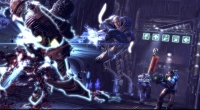
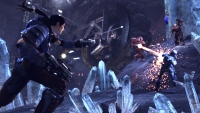
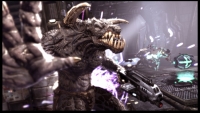
BU: Are all three platforms really going to be identical, despite the different hardware and software that is built into/available for each?
SP: UT will feature the same levels, weapons, vehicles, and game types on each platform. Having said that, the game will not feel identical on each platform, as we’ve tweaked the game for each platform so as not to compromise the game play on any system. The game plays a bit slower on the console versions, and there is some aiming help (although the system we’ve developed, while very effective, feels quite subtle). Visually, the game scales very well to a wide variety of hardware. We’ve always placed a lot of emphasis on getting UT to run well on lower end hardware, and we’ve also got high end features to push your monster PC to its limits.
And of course, we’ll be supporting mods on both the PC and PS3. Mod support has always been an important part of our success on PC, so we’re very excited to be able to bring this feature to a console platform.
BU: Can you elaborate specifically about what will be different in the PC version: ie menu/gui/features/textures?
SP: We’ve authored our content to support scaling the visual bar to match your system’s specs. With texture streaming support on all platforms, there won’t be much difference in texture fidelity based on your hardware, but high end PCs will see differences in character detail, dynamic lighting, etc. Of course, the user interface will be significantly different on PC to take advantage of mouse and keyboard input, as well as PC monitor resolution.
BU: Why were CTF and vCTF combined? Will they be filterable?
SP: Actually, they are separate game types now, with separate tabs in the server browser.
BU: What, if any, changes have been made to the Translocator?
SP: The translocator still has regenerating charges, but it recharges a bit faster. The puck’s trajectory arc has also been modified – it’s flatter to make it easier to aim, but doesn’t go as far as the 2k4 version (max distance is between UT99 and UT2K4).
BU: What are some of the UT 2004 DM and CTF weapon and gameplay challenges that you will address with UT 3?
SP: We’ve gone to a lot of effort to improve the movement feel, and the changes we’ve made to movement have also allowed us to make the scale of the environments more believable without cramping gameplay. We’ve done some tweaking to weapons to make sure that projectile weapons and hit scan weapons are appropriately balanced. Replacing the shieldgun with the impact hammer also addressed balance issues with flag running in CTF.
BU: Are there any new weapons being planned for non-vehicle gametypes? how about vehicle gametypes?
SP: Most of the returning weapons have significant new functionality. For example, the impact hammer alt fire is a small emp blast that can damage vehicles, or knock power ups off of enemy players. The stinger minigun still has a hitscan primary fire, but the alternate fire shoots large shards which can impale an enemy and pin them to a wall.
The big addition to your arsenal is the deployables, which can both be carried by hand, or deployed from a couple of special purpose vehicles. One example of a deployable is the spider mine trap. When an enemy comes nearby, spider mines emerge from it and scurry after him. In addition, the AVRiL laser guidance can be used to “herd” friendly spidermines, like the spidermine launcher did in UT2004.
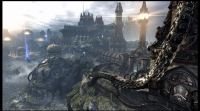
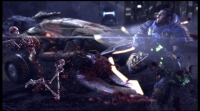
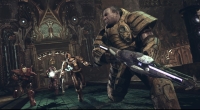
BU: Are there any vehicle vs players-on-foot balance issues from UT 2004 that you will address with UT 3?
SP: One big issue in UT2004 was manta spawn-camping. A player in a manta could spawn rape all the playerstarts at a node pretty easily. We’ve tweaked the manta to address this issue, without a substantial impact to the manta’s ability to run over people.
BU: Has Onslaught been combined with Warfare to create a single gametype?
SP: There is no longer a separate Onslaught game type. Warfare combines the Onslaught and Assault game types from past Unreal Tournaments, with nodes and the PowerCore providing an overall strategic flow while special objectives and the orb provide unique missions within the match. With the flexible warfare objective system, level designers can create levels that play like classic Onslaught or classic Assault. The orb system has gone through a lot of iteration, and we’re really excited about the game play mechanics we’ve settled on for the orb. We no longer have separate “conduit” objectives. Each team has a single orb, and the orb can be delivered to a node to instantly capture it, or defensively used to lock down and shield a node. This has proved to work very well in practice, allowing rapid coordinated counterattacks as well as the ability to really defend a critical node effectively. Playing as an orb runner allows you to be a hero, and gives you the same kind of adrenaline rush as making a flag run in CTF.
BU: Keeping in mind that design changes are made throughout the development of a game, we kind of went from hearing that Warfare would be large scale warfare with three teams over multiple dynamic maps with "commander" roles and deployables to Onslaught with objectives. Which is accurate?
SP: The Warfare game type has certainly evolved quite a bit over the course of development. A key aspect of our development process was constant gameplay iteration. We tried out all our new ideas in play tests, and modified or discarded them based on whether they were fun or not. As a result, a lot of concepts that sounded cool when you describe them were discarded because they were quite flawed in practice. Even so, there are many cool new elements in Warfare that remain from our original concept, including deployables, special objectives, the orb system, and asymmetric battles between Necris and human forces. Each warfare map supports multiple layouts, allowing it to scale to different player counts, change what vehicles and deployables are available, or whether the mission should be symmetric or asymmetric.
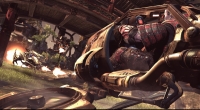
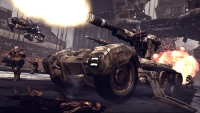
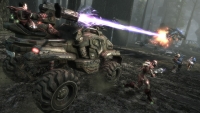
BU: Are there still plans to include community features like demo recording, irc chat, and news? Anything new in that respect?
SP: We’ll have these features and more (including a lot of cool new stats features). We’ll talk more about these features in the next few weeks.
BU: How concerned is Epic with cheating and what is being done to keep them out of UT3 servers? (i.e. in-house? third party?)
SP: Controlling cheaters is critical to the longevity of a multiplayer online game. We’re making significant improvements to cheat prevention and player authentication. Robust authentication is critical for keeping cheaters from stealing the keys of legitimate players, and allows us to more effectively ban cheaters when necessary.
BU: What are some of the ways that Kismet is being used in UT3 level designs?
SP: Kismet is of course heavily used by all the special objectives in the Warfare maps. Level designers have found a lot of other creative uses for it in the classic game types as well, such as a high tech garbage disposal trap in a robot factory deathmatch map, or the ship delivering the darkwalker in Heatray. It’s also used by level designers to make the levels feel more dynamic, and to make level objects like lifts much more complex and interesting. While we’ve done lots of cool things with Kismet, I can’t wait to see what creative things the community level designers come up with to leverage this powerful system.
Thanks, Steve, for taking the time to talk with us!

